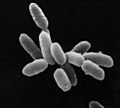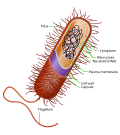A halophile (from the Greek word for 'salt-loving') is an extremophile that thrives in high salt concentrations. In chemical terms, halophile refers to... 22 KB (2,705 words) - 10:21, 13 March 2024 |
halotolerance and is a portion of many words: Halobacteria Haloclasty Halophile Halophyte Halo (disambiguation) This disambiguation page lists articles... 306 bytes (60 words) - 14:32, 2 March 2015 |
 | Dunaliella salina is a type of halophile unicellular green algae especially found in hypersaline environments, such as salt lakes and salt evaporation... 11 KB (1,368 words) - 14:12, 22 April 2024 |
 | Sea salt evaporation pond at Walvis Bay. Halophile organisms giving a red colour.... 14 KB (1,447 words) - 19:42, 4 April 2024 |
halide, halieutic, halite, halochromic, halochromism, halogen, halomancy, halophile, halophyte, oxohalide, thermohaline hal-, -hel- breathe Latin halare,... 1 KB (1,336 words) - 06:14, 16 April 2024 |
 | in height, most of the rest are cactus, with some mangroves and other halophile plants. Many plants are rainfall sensitive, with most trees and shrubs... 164 KB (19,703 words) - 17:40, 13 March 2024 |
 | Halocline – Stratification of a body of water due to salinity differences Halophile – organism that thrives in high salt concentrations List of bodies of... 7 KB (721 words) - 04:38, 27 March 2024 |
 | Southern cleavers, דבקת הפטמות Galium verrucosum Flore Alpes Gaillet halophile Flora Vascular de Andalucía Occidental, Galium verrucosum Wild Plants... 2 KB (122 words) - 06:04, 21 June 2022 |
Kang, KH; Park, YH (July 2003). "Erythrobacter flavus sp. nov., a slight halophile from the East Sea in Korea". International Journal of Systematic and Evolutionary... 3 KB (179 words) - 13:59, 11 March 2022 |
Marinobacter daqiaonensis (category Halophiles) Sun, X (December 2011). "Marinobacter daqiaonensis sp. nov., a moderate halophile isolated from a Yellow Sea salt pond". International Journal of Systematic... 2 KB (157 words) - 20:11, 22 November 2023 |
 | Shiladitya DasSarma (section Halophiles) widely known to have been instrumental in the foundation of the fields of halophile and extremophile research. In early work (1980's), he discovered mobile... 14 KB (1,429 words) - 15:59, 17 December 2023 |
Salinirubellus salinus is an halophile archaeal species. It was first isolated from a marine solar saltern in Zhejiang Province in China. It is the only... 1 KB (79 words) - 16:07, 11 February 2023 |
 | "Purification and characterization of aspartate aminotransferase from the halophile archaebacterium Haloferax mediterranei". The Biochemical Journal. 278... 19 KB (2,115 words) - 13:27, 22 July 2023 |
 | Halocline – Stratification of a body of water due to salinity differences Halophile – organism that thrives in high salt concentrations Hypersaline lake –... 9 KB (1,129 words) - 06:19, 14 March 2024 |
sugar concentrations (e.g., brines or sirups). Osmophiles are similar to halophiles (salt-loving organisms) in that a critical aspect of both types of environment... 2 KB (220 words) - 13:43, 23 January 2024 |
Halomonas organivorans is a halophile able to degrade aromatic compounds. It's considered a potentially useful bacteria for decontamination of polluted... 2 KB (181 words) - 02:28, 9 November 2021 |
 | Haloarchaea (category Halophiles) distinguish them from halophilic bacteria. These microorganisms are among the halophile organisms, that they require high salt concentrations to grow, with most... 29 KB (2,964 words) - 04:39, 8 April 2024 |
 | Halobacterium salinarum (category Halophiles) salterns. As these salterns reach the minimum salinity limits for extreme halophiles, their waters become purple or reddish color due to the high densities... 25 KB (2,471 words) - 00:52, 8 November 2023 |
 | "Net Charges of the Ribosomal Proteins of the S10 and spc Clusters of Halophiles Are Inversely Related to the Degree of Halotolerance". Microbiol. Spectr... 65 KB (7,263 words) - 17:49, 12 April 2024 |
 | of an archaeon was performed in 1971, when the RNAP from the extreme halophile Halobacterium cutirubrum was isolated and purified. Crystal structures... 41 KB (4,799 words) - 19:34, 17 April 2024 |










